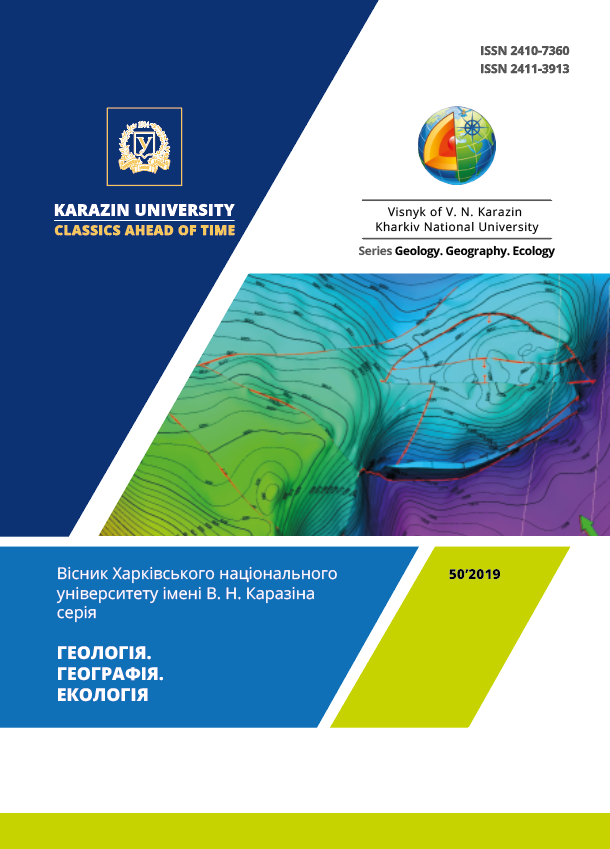Landscape-ecological investigations mapping of V. V. Dokuchayiv KHNAU arboretum’s territory
Abstract
Formulation of the problem. This article briefly describes the main problems that arise during landscape and ecological investigation of territories. On the example of V.V.Dokuchayiv KHNAU’s arboretum the comparative and ecological method of estimating the soil conditions for the forest-based effect, i.e. species composition and productivity of indigenous forest vegetation groups is considered. The forest represents a system of vegetation and habitat. From the ecological point of view it is a reflection of the environment, as its forestry effect. The objective is also to justify measures aimed at solving urgent landscape and environmental problems, namely, transformation and pollution of the natural environment, the development of morphodynamic processes.
Soils, as the element of the landscape, are an important block of ecosystems whose destruction has a multidimensional value for the stability of the natural environment. Aggregate soil transformation has traditionally been evaluated as progressive. However, scientific analysis suggests that extensive farming, inappropriate chemical fertilization and fetishization of pesticides have led to a significant decline in fertility, and in some cases, its loss due to the development of erosion of natural soil cover on large areas. Such processes stimulate soil microflora to decompose organic contaminants and promote the absorption of harmful substances by the plant.
The landscape-ecological approach is currently used in solving many scientific problems: both theoretical and practical.
The purpose of the article. The purpose of this work was to study the landscape and ecological structure of the forest massif, to identify the relationship between the components of landscapes on the example of the V.V. Dokuchayiv KHNAU’s arboretum by mapping the territory.
Methods. The authors’ own achievements as well as the research results of domestic and foreign investigators made the methodical basis for the article.
Results. The content of heavy metals on the territory of the arboretum is investigated, a ranking of factors influencing the distribution of concentrations of pollutants has been carried out and the type of ecological situation is determined by means of mapping methods.
Modern and ecological methods of disturbed territories’ restoration with the help of phytotherapeutic technologies, which are much cheaper and safer, are offered. When implementing phytoremediation methods, there is less secondary pollution, physical and granulometric composition of soils does not deteriorate, biological activity does not decrease, and productivity is kept constant. This technology is most convenient for cleaning of moderately polluted soils.
Scientific novelty and practical significance. One of the main mechanisms for regulating the ecologization of land resources is the identification, evaluation and implementation of the maximum possible reserves for increasing the efficiency of this process. This is reduction of unproductive losses in the mode of use and conservation of resources and the possibility of using the basic solution as a scientific and technological progress. Digital terrain models are designed for interactive visualization and have an effect of presence on the ground. Such models are used to substantiate measures to optimize land use in order to restore and stabilize the ecological situation, assess the natural recreational potential of the territory, monitor the components of the environment, predict transformation and degradation processes and environmental phenomena development.
Downloads
References
Sinna O.I. Landshaftno-ekologichne kartografuvannya regionalnogo rivnya: sutnist ta suchasni napryamy. Available at: www.irbis-nbuv.gov.ua/.../cgiirbis_64.exe?
Rudenko L.G., Chabanyuk V.S., Bondar A.L. [ta In.] (1994). KontseptsIya bagatotsIlovoYi NatsIonalnoYi GIS UkraYini [The concept of multipurpose National GIS of Ukraine]. Vinnitsya, 4-33.
Peresadko V.A. (2009). Kartohrafichne zabezpechennia ekolohichnykh doslidzhen i okhorony pryrody. [Carto-graphic support for environmental research and conservation], 242.
Peresadko V.A. (2009). Naukovi osnovy rehionalnoho ekoloho-pryrodookhoronnoho kartohrafuvannia. [Scien-tific fundamentals of regional ecological and environmental mapping], 40.
Chervanov I.H. (2007). Modeli heodynamiky reliefu v doslidzhenniakh i rozrobkakh Kharkivskoi heomorfolohich-noi shkoly. [Models of geodynamics of relief in researches and developments of Kharkiv geomorphological school], 39-44.
Peresadko V.A. (2004). Kartohrafichni tvory yak osnova stvorennia rehionalnoi ekoloho-heohrafichnoi HIS [Car-tographic works as the basis for creation of regional ecological-geographical GIS], 222-226.
Ehlers M., Edward G., and Bedard Y. (1989). Integration of Remote Sensing with Geographic Information systems: A Necessary Evolution. Photogrammetric Engineering and Remote Sensing, 55, 11.
Geoenvironmental Mapping – Methods, Theory and Practice (2001). Edited by P.T. Bobrowsky, A.A. Balkema. Pub-lishers, P.O. Box 1675, 3000 BR Rotterdam, The Netherlands, 725.
Oosterom P. Research and development in 3D cadastres (2013). Environment and Urban Systems., 40, 1, 1-6.
Ysachenko G. A. (1999). Metodi polevix landshaftnix yssledovanyj y landshaftno-ekologycheskoe kartografyrovanye. [Methods of field landscape research and landscape-ecological mapping]. S.-Peterb, 3.
Ostapenko B.F., Tkach V.P., Pasternak V.P. (1996). Optymizatsiia lisomelioratyvnoho kompleksu v ahrolandshaftakh Lisostepu. [Optimization of the forest- ameliorative complex in agrolandscapes of forest steppe]. Kharkiv, 50.
Odum Yu. (1986). Ekolohyia [Еcology]. Moskva, 376.
Vorobev D.V., Ostapenko B.F. (1981). Ekolohycheskye osnovi lesorazvedenyia [Ecological basis of afforestation]. Kharkiv, 108.
Ostapenko B.F. (1978). Lesovodstvoenno-ekolohycheskaia typolohyia y ee klassyfykatsyonnaia systema: lektsyia. [Forestry-ecological typology and its classification system]. Kharkiv, 69.
Kholupiak K.L. (1972). Ustroistvo protyvoerozyonnikh lesnikh nasazhdenyi. [Device of anti-erosion forest plant-ings]. Moskva, 152.
Kuzmychev V.P. (1978). Otsenka urovnia эffektyvnoho plodorodyia pochv. [Assessment of the level of effective soil fertility]. Moskva, 124–125.
Ostapenko B.F., Sytnik I.I. (2011). Parky Kharkivskoho natsionalnoho ahrarnoho universytetu im. V.V. Dokuchaieva. [Parks of V.V. Dokuchayiv Kharkiv National Agrarian University]. Kharkiv, 184.
Sytnik I.I. (2013). Profesor B.F. Ostapenko i zelena zona ahrouniversytetu. Available at: http://nbuv.gov.ua/UJRN/Vkhnau_grunt_2013_1_41І. Kharkiv, 181-183.
Dendrologichniy park. Available at: [Dendrological Park]: https://knau.kharkov.ua/dendropark.html.
Reshetchenko S.I., Tkachenko T.H. (2016). Osoblyvosti rozpodilu atmosfernykh opadiv na terytorii Kharkivskoi oblasti. [Peculiarities of the distribution of atmospheric precipitation in the territory of Kharkiv region]. Kharkiv, 148-152.
Kravetsʹ O.P. (2002). Suchasnyy stan ta problemy fitoochyshchennya gruntiv vid radionuklidiv i vazhkykh metaliv. [Current status and problems of soils reclamation from radionuclides and heavy metals], 34(5), 377–386.
Biletsʹka V.A., Yatsechko N.YE., Pavlychenko A.V. (2013). Doslidzhennya protsesiv transformatsiyi vodoroz-chynnykh form vazhkykh metaliv pry detoksykatsiyi promyslovykh vidkhodiv pryrodnymy sorbentamy. [Investiga-tion of heavy metals soluble forms transformation in detoxification of natural sorbents in industrial waste] Available at: http://rr.nmu.org.ua/pdf/2013/20131016-52.pdf





